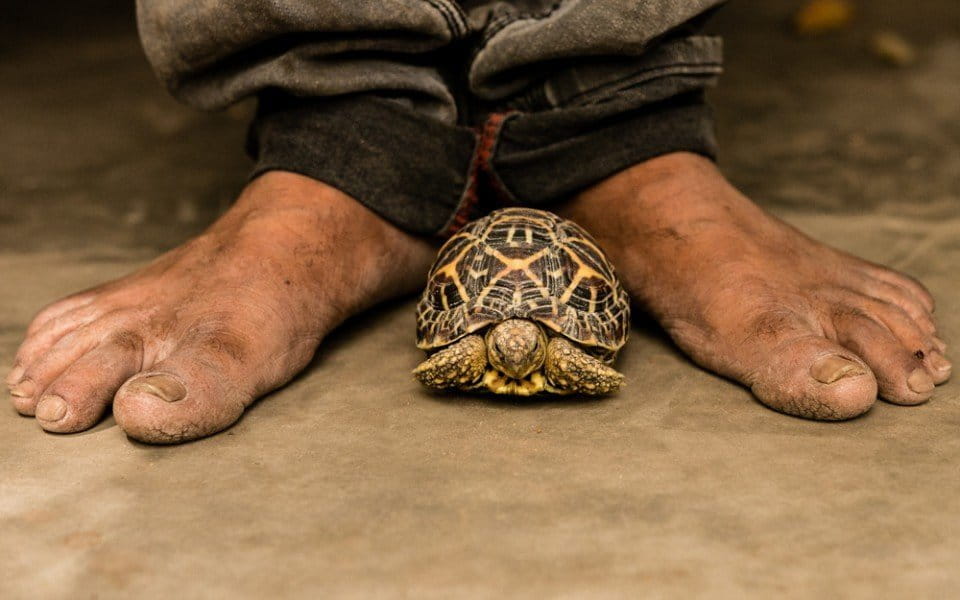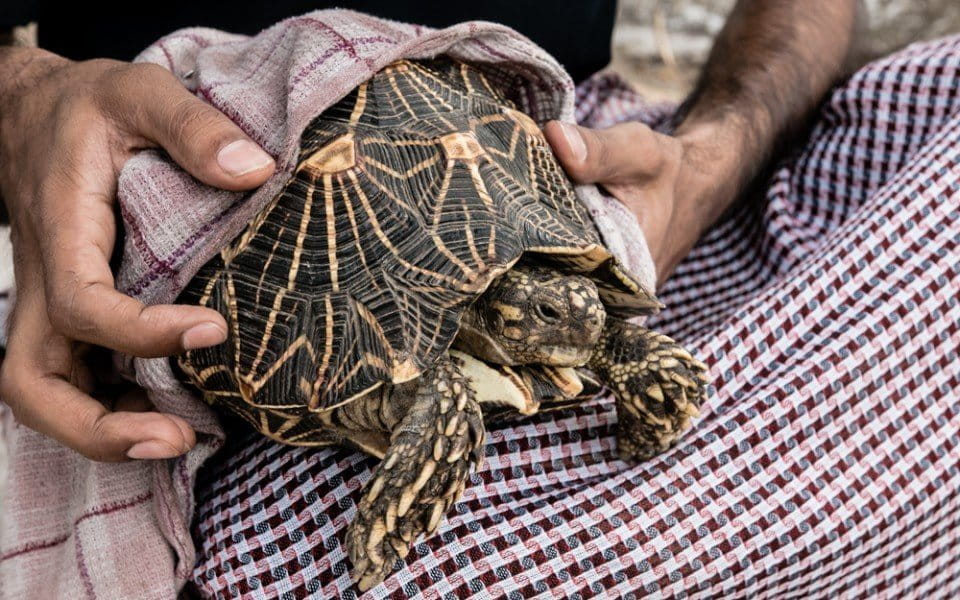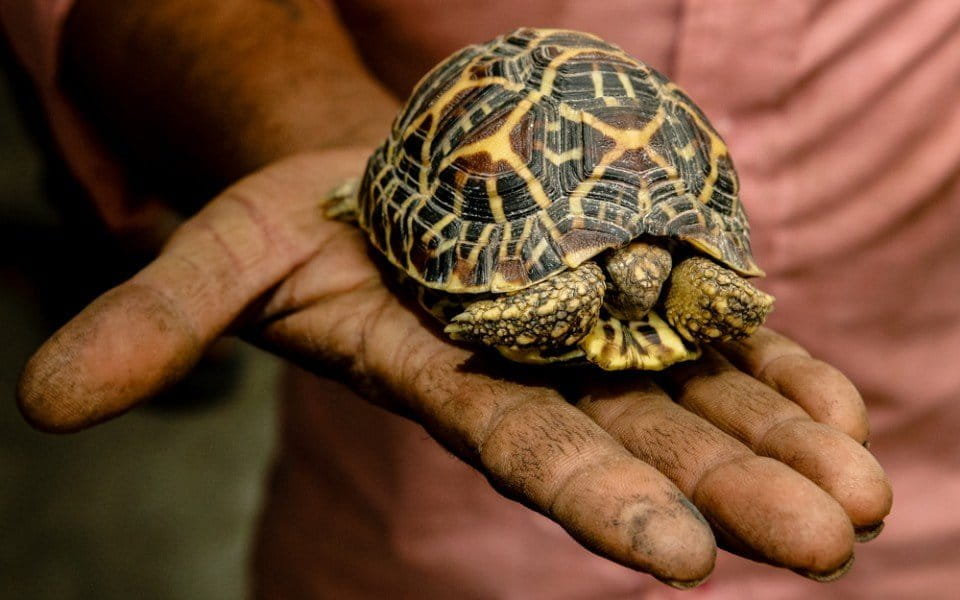- The Indian star tortoise is popular as a pet and spiritual symbol.
- Study found evidence of a large-scale network of illegal tortoise trade in southern India.
- After being transported to eastern India, these tortoises are shipped off to other Asian countries like Thailand, Malaysia, Singapore and China, researchers found.
The Indian star tortoise (Geochelone elegans) is a little-known, but common, victim of illegal wildlife trade. In 2014, at least 55,000 wild tortoises were poached from just one “trade hub” in southern India, a recent study published in Nature Conservation has uncovered.
“We were most shocked at the sheer scale of the illegal trade in this species,” Neil D’Cruze, lead author from the University of Oxford and Head of Research at World Animal Protection, UK, told Mongabay. “A great deal of suffering is involved too — stuffed into sacks and suitcases, cracked shells stress and associated disease is rife and many do not survive the arduous smuggling process.”
The Indian star tortoise is popular as a pet and a spiritual symbol, largely because of its striking shell that has a star-like radiating pattern of yellow and black. However, no one had taken a closer look at where the tortoises were coming from, D’Cruze said.

The star tortoise’s status in the wild was last assessed 15 years ago in 2000, he added, when it was categorized under ‘Least Concern’ on the IUCN Red List.
Concerned about the tortoise’s current status in India’s wilderness — where they typically occur in grasslands and scrub forests — D’Cruze and his team initiated a 17-month investigation in two Indian states to try and find some answers.
The team found that in the state of Gujarat in west India, star tortoises were being openly kept as pets, primarily because people considered them to be good omens. Researchers found over 100 star-tortoise hatchlings in a single household, for example.

The team also found that the Indian star tortoise was common in religious temples, because the animal is “believed to represent an incarnation of the Hindu God ‘Vishnu’,” the authors write. These temple star tortoises reportedly come directly from the wild rather than from vendors, they add.
Despite the prevalence of star tortoises in people’s homes and temples, the team did not find evidence that placed Gujarat as a center for organized illicit transport of Indian star tortoises to other countries.


In southern India, however, the team detected the presence of a large-scale network of illegal tortoise trade. Local collectors supply Indian star tortoises, sourced from the wild, to international customers via a series of middlemen, the study found.
For example, between January and December 2014, the researchers observed that rural forest-dwelling communities in the states of Karnataka, Tamil Nadu and Andhra Pradesh collected more than 55,000 juvenile wild tortoises. These primary collectors typically sold the animals to urban traders for a sum of 50 to 300 Indian rupees ($1 to $5) per animal, the team found.
“Animals are often wrapped in cloth and packed into suitcases,” the authors write. “However, to avoid detection by enforcement agencies, some are also placed into boxes filled with a top layer ‘mask’ of other legal produce such as fruit, vegetables, crustaceans and fish.”
After moving through a series of middlemen, these tortoises are then transported via rail or road to eastern India, from where they are shipped off to other Asian countries like Thailand, Malaysia, Singapore and China. Sometimes, international passengers act as couriers too, the researchers write.
“Unfortunately our worst nightmare appears to have come true,” D’Cruze said. “Sophisticated criminal gangs are exploiting both impoverished rural communities and urban consumers alike. Neither group is fully aware how their actions are threatening the welfare and conservation of this species.”

Loopholes in the legal system add to the problem, he added.
The star tortoise is included in the Schedule II of the Convention on International Trade in Endangered Species of Wild Fauna and Flora (CITES), which allows international trade in the species, provided permits are in place. However, to protect wild star tortoise populations, India has put an additional layer of legal protection on these tortoises by placing them under Schedule IV of the Wildlife (Protection) Act of 1972. This makes it illegal to “possess or commercially trade in this species either within or from India,” the authors write.
Despite this, the researchers found evidence of rampant international trade in star tortoises, mostly illegal. In particular, they found large discrepancies between imports and exports relating to Thailand, one of the major international markets for illegal tortoises. For example, CITES records show that Kazakhstan is the main supplier of star tortoises to Thailand, although it is not a range country for this species, the authors write.
“Despite being protected in India since the 1970’s, legal ‘loopholes’ in other Asian countries such as Thailand and China appear to undermine India’s enforcement efforts,” Gajender Sharma, India Director at World Animal Protection, said in a statement.
But the impact of unregulated collection of tortoises, and their trade, on wild populations is still unknown.

Despite the paucity of information, D’Cruze’s team suggests listing of the Indian star tortoise as a threatened species on the IUCN Red List as a precautionary approach.
“The take home message is that we are dealing with an organized international criminal operation which requires an equally organized international approach to combat it,” D’Cruze. “We support existing calls for countries in this region to implement corresponding national bans regarding the commercial trade of Star tortoises.”

Citation:
- D’Cruze N, Singh B, Morrison T, Schmidt-Burbach J, Macdonald DW, Mookerjee A (2015) A star attraction: The illegal trade in Indian Star Tortoises. Nature Conservation 13: 1–19. doi: 10.3897/natureconservation.13.5625